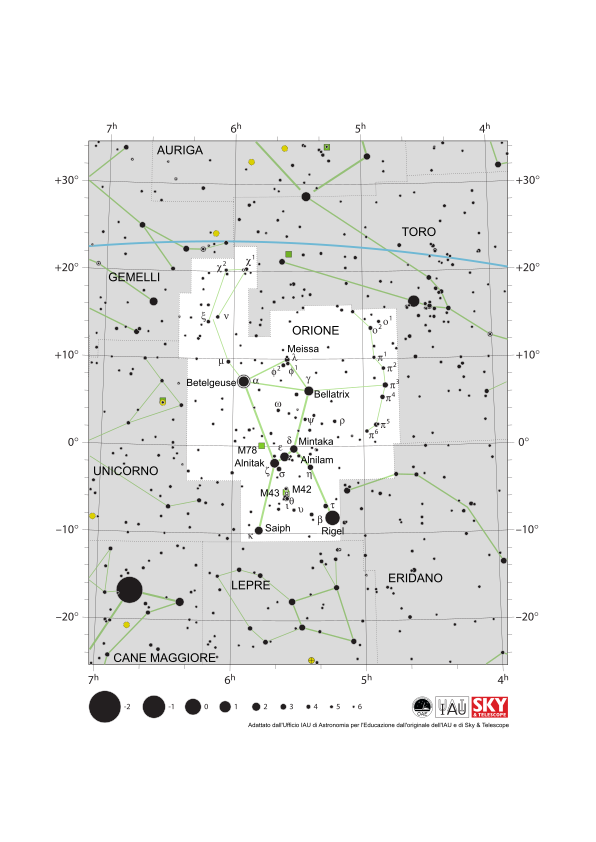This page describes an image Mappa della costellazione di Orione
Scarica il file PDF (PDF file 233.65 kB)
Diagram caption:
La costellazione di Orione con le sue stelle luminose e le costellazioni circostanti. Orione è circondata da (in senso orario dall'alto) Toro, Eridano, Lepre, Unicorno e Gemelli. Le stelle più luminose di Orione, Betelgeuse e Rigel, si trovano rispettivamente all'estremità settentrionale (in alto in questo diagramma) e meridionale (in basso) della costellazione, con la famosa "cintura" di tre stelle al centro.
Orione si estende sull'equatore celeste ed è quindi visibile in alcuni periodi dell'anno da tutto il pianeta Terra. Nelle regioni più artiche o antartiche del mondo, alcune parti della costellazione potrebbero non essere visibili. Orione è più visibile la sera nell'emisfero settentrionale in inverno e nell'emisfero meridionale in estate. La linea blu sopra Orione segna l'eclittica, il percorso che il Sole sembra compiere attraverso il cielo nel corso di un anno. Il Sole non passa mai per Orione, ma occasionalmente si possono trovare in Orione gli altri pianeti del sistema solare e la Luna.
A sud della cintura di Orione si trovano i due oggetti Messier M42 (la nebulosa di Orione) e M43, contrassegnati da quadrati verdi. Queste nebulose, insieme a M78 (qui il quadrato verde a sinistra della cintura), fanno parte dell'enorme complesso Molecolare Nebuloso di Orione. Questo copre la maggior parte della costellazione e comprende regioni in cui queste nubi molecolari stanno collassando per formare giovani inizi.
L'asse y di questo diagramma è in gradi di declinazione con il nord in alto e l'asse x è in ore di ascensione retta con l'est a sinistra. Le dimensioni delle stelle qui segnate si riferiscono alla magnitudine apparente della stella, una misura della sua luminosità apparente. I punti più grandi rappresentano le stelle più luminose. Le lettere greche indicano le stelle più luminose della costellazione. Queste sono classificate in base alla luminosità: la stella più luminosa è etichettata come alfa, la seconda più luminosa come beta e così via, anche se questo ordine non viene sempre seguito esattamente. Il cerchio intorno a Betelgeuse indica che si tratta di una stella variabile. Le linee tratteggiate delimitano i confini delle costellazioni stabiliti dall'IAU e le linee solide verdi indicano una delle forme comuni utilizzate per rappresentare le figure delle costellazioni. Né i confini delle costellazioni né le linee che uniscono le stelle appaiono nel cielo.
Diagram credit: Adattato dall'Ufficio IAU di Astronomia per l'educazione dall'originale di IAU/Sky & Telescope. Link per i Crediti
Stato di traduzione del Diagramma: Non ancora approvato da un revisore
Traduttori del Diagramma: Giuliana Giobbi
Termini di glossario connessi:
Ascensione retta (RA)
, Coordinate celesti
, Costellazione
, Declinazione
, Eclittica
, Gemelli
, Magnitudine apparente
, Orione
, Toro
, stella variabile
Categorie:
Astronomia ad occhio nudo
Diagram license: Creative Commons Attribuzione 4.0 Internazionale (CC BY 4.0) Creative Commons Attribuzione 4.0 Internazionale (CC BY 4.0) icone
In Altre Lingue
Inglese: Orion Constellation MapCinese tradizionale: 獵戶座星圖
Cinese semplificato: 猎户座星图
Spagnolo: Mapa de la constelación de Orión
Se noti un errore in questo diagramma, o nella sua didascalia, per favore contattaci.









